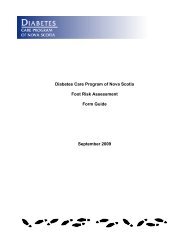CDE Appendix 1 Literature Review - Central East Local Health ...
CDE Appendix 1 Literature Review - Central East Local Health ...
CDE Appendix 1 Literature Review - Central East Local Health ...
You also want an ePaper? Increase the reach of your titles
YUMPU automatically turns print PDFs into web optimized ePapers that Google loves.
The Culture, Diversity and Equity Project: <strong>Literature</strong> <strong>Review</strong><br />
Treatment/<br />
Follow-up<br />
• Practice guidelines<br />
and treatment<br />
framework that<br />
account for<br />
differences related<br />
to culture<br />
• Makes<br />
accommodations to<br />
and integrates client's<br />
traditional health<br />
beliefs and practices,<br />
as appropriate<br />
• Utilizes community<br />
resources as treatment<br />
partners, as<br />
appropriate<br />
• Provides client- and<br />
population-level health<br />
education around<br />
issues that are<br />
specifically relevant in<br />
the community<br />
• Regularly assesses<br />
treatment processes<br />
and outcomes related<br />
to<br />
ethnic/cultural/languag<br />
e groups as part of<br />
quality monitoring and<br />
improvement program<br />
• Individualized interventions<br />
applied in a patient- and<br />
family-centered fashion<br />
• Patient instructions (written<br />
and oral) reflect cultural<br />
competence<br />
• Care-facilitating outreach to<br />
clients/population from<br />
relevant cultural groups<br />
• Public health interventions<br />
reflecting needs of population<br />
in service area<br />
" Culture-specific quality<br />
assurance reports<br />
Part II: Intermediate Outcome Indicators<br />
INTERMEDIATE OUTCOME INDICATORS<br />
ALL DOMAINS<br />
ORGANIZATIONAL<br />
PERSPECTIVE<br />
CLIENT PERSPECTIVE<br />
COMMUNITY<br />
PERSPECTIVE<br />
Organizational Values<br />
Governance<br />
Planning and<br />
Monitoring/Evaluation<br />
Communication<br />
Staff Development<br />
Organizational<br />
Infrastructure<br />
Services/Interventions<br />
• Rate of<br />
appropriate use<br />
of services<br />
relative to need<br />
• Retention of<br />
clients/reduced<br />
attrition rates<br />
• Reduction in<br />
rates of broken<br />
appointments/n<br />
o-shows<br />
• Reductions in<br />
misdiagnoses<br />
and inadequate<br />
treatment plans<br />
• Rates of<br />
appropriate<br />
management of<br />
selected chronic<br />
conditions<br />
• Staff<br />
• Perceptions regarding:<br />
- cultural competence of<br />
providers/organization<br />
- how well organization meets their<br />
needs<br />
• Satisfaction with care<br />
• Knowledge/understanding regarding<br />
prevention, diagnosis, treatment<br />
plan<br />
• Agreement/compliance/adherence<br />
with treatment plan<br />
• Medication compliance/reduction in<br />
misuse of medications<br />
• Improved management of selected<br />
chronic conditions<br />
• Increase in healthy behaviors and<br />
prevention practices/reduction in<br />
risky behaviors<br />
• Opinions<br />
about the<br />
organizatio<br />
n and its<br />
responsiven<br />
ess to<br />
community<br />
needs<br />
118

















